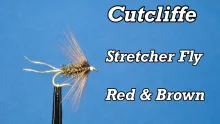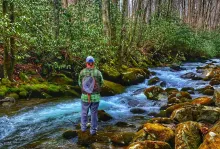Hans Jacob, a good friend of mine, has been going to some lakes in Sweden for many years, and asked whether some of us wanted to join him on another summer fishing trip. I wasn't late to return with a confirmation. Sure I wanted to fish lake rainbows with him! Sounded like a lot of fun. And it was!
Hans Jacob, a good friend of mine, has been going to some lakes in Sweden for many years, and asked whether some of us from the fly fishing gang wanted to join him on another summer fishing trip. I wasn't late to return with a confirmation. Sure I wanted to fish lake rainbows with him! Sounded like a lot of fun. And it was!
A nature reserve
The area is called Hökensås (pronounced her-ken's-owes), and is a nature reserve with public access and a very well run lake fishery as well as access to stream fishing if you want (and buy a license). It's the lakes that are the main attraction. There are twenty lakes available and a licensing system that will allow you to fish a few, some or all of the lakes. You can fish spin, bait and fly depending on the lake, and some are laid out as family lakes with easy access and more but smaller fish.
Most lakes have easy car access and parking right on the bank, and many have both tables, benches and barbeques for public use. You can stay on the camping ground or in a cabin in the area, but the usual Swedish allamannsrätt (which literally means every man's right), which allows putting up a tent almost everywhere in nature in Sweden is not in effect here since we're in a nature reserve. So you have to use the existing facilities.
We only fished two lakes out of those available on the license, mostly because they are beautiful lakes, but also because they are fly fishing only and allow for float tubes and pontoon boats. Fishing from a tube or boat can be a great benefit for several reasons: access to the water can be difficult in these lakes, where you sometimes will have to hike long ways around the lakes to get to suitable fishing spots.
Secondly there are only few spots in the lakes where you can wade. Lakes generally have soft bottoms, and you need sand or rocks to get comfortably into the water. You could of course fish from the dry bank, but these are forest lakes, and you will always have tonnes of trees in your backcast and most likely a reed zone in front of you.
And last but not least: during the summer, fish tend to seek into the deeper parts of the lakes to find colder water, and the deeper parts tend to be in the middle of the lakes, far from the banks.
So a sailing device is a nice thing to have when you fish lakes.
Stocked lakes
These lakes are stocked with rainbows, but also have a population of wild trout as well as both pike, perch and rudd. People mainly fish for the rainbows, which are nice and healthy fish in the 2-3 kilo range with a few specimens even larger. I don't know how often the lakes are stocked, but judging from the behavior and condition of the fish, it's not that often, because the fish definitely act as wild fish. You are allowed to keep fish, but there's a bag limit depending on your license. We released all the fish we caught.
The lakes are very nice and clean, and even though they are not clear watered as such, but more peaty as forest lakes often are, the water is nice and clean, and both plant and insect life indicates a very fine environment.
All the lakes have hatches, primarily caddis or sedge, but there are also mayflies hatching, and during our stay we experienced one evening with very good Ephemera vulgata hatches and lots of surface activity.
On such occasions it's an obvious choice to fish for rising fish with a dry fly, and flies such as large mayflies, caddises and different terrestrials can work really well. A twitched caddis fly can be a killer when the fish are in that mood. Emergers are also an excellent choice, and nymphing can work well too, although the more traditional lake fishing methods with buzzers or midge larvae rarely seem to be in use here.
Equally popular to the fishing with smaller imitations is fishing with large buggers in the depth. A sinking line and a weighted Zonker, Woolly Bugger, Montana Nymph or a similar fly can be a killer during the summer where the fish often stay deep, especially during very warm and sunny periods.
I tried a couple of very different tactics, which both proved to work very well: the emerging monster and harling.
The emerging monster
The emerging monster came to me when I had been fishing on the surface during our first evening with no results at all. I thought about getting my sinking rig in the car, but before going back there I simply rigged a heavy fly on the floating line. Fate would have it that I had some Klympen flies in my pocket, and even though this fly is made for coastal fishing, I thought that its weight and general buggy look earned it a chance. I tied it on a long 5X or 0.16 millimeter tippet, cast it out and let it sink, piling some loose line in front of the pontoon boat, and started rowing.
As soon as the fly line stretched and the fly started fishing, I hooked a fish! Nice!
I fought and landed my first rainbow of the week, and cast out the fly again, added some slack line and took a few takes with the oars and bam! Fish again!
I had accidentally found a fishing method that would prove to work almost every day the rest of the week.
One of the days I was fishing over a deeper hole, and added a very heavy nymph to a piece of tippet tied to the hook bend of the large hook. My theory was that this would bring everything further down, and whether this was the case or not, I don't know, but the rig also produced. I had fish on both the nymph and the larger fly, which in hindsight probably looked very much like an emerging mayfly or caddis shooting up from the depth to hatch in the surface.
Harling
Harling is the name of a technique where a fly is trolled after a boat. Originally it referred to using a streamer on a sinking line drawn after a rowboat, but these days the term is used for many types of fly fishing from a boat. According to some, this isn't fly fishing, because you don't really cast and retrieve, but I honestly don care. It works and it's fun!
Again this came almost as an accident. I had been unproductive with my newly discovered monster emerger technique, and since I at no point caught anything while trolling this rig after the pontoon boat, I thought I'd exchange the emerger with a real streamer. Again I dived into my sea trout fly box, and dug out the largest hair wing streamer I could find; a no-name pattern with a golden body, orange and black hair as a wing a few peacock herl on top.
I was fishing a floating line, so the fly moved fairly high in the water, and I sailed rather slowly with gentle strokes of the oars both to keep the pace down and to disturb the surface as little as possible. And lo and behold! Lady Luck smiled at me again, and on my first pass across the lake I had a hookup! And again this method worked consistently over the days, and again I extended it with an extra fly, this time adding an unweighted olive Wooly Bugger to the hook bend of the streamer. I had several fish on this bugger.
Facts
Hökensås is located in mid-Sweden close to the large lake Vättaren. There are cabins and houses for hire in the area, but if you want to put up a tent or park an RV that's also possible. The cabins are primitive with no shower or toilet, but with four beds, a fridge and a small kitchen area and rent for about 500 SEK per day (about 80 USD). Houses are much more comfortable with bathroom, separate kitchen and room for six, but also cost about 900 SEK per day (140 USD or about 100 Euros).
The licenses range from about 100 SEK (15 USD or 10 Euros) for a single lake afternoon license to about 190 SEK (30 USD or 20 Euros) for full access to all lakes for 24 hours.
You can find more information online in Swedish, German and English.
Lessons learned
I learned a few things during my stay in Hökensås:
1)
Lake fishing in stocked lakes can be a lot of fun. The stocked lakes I have fished here in Denmark have all been butt ugly and with really disgusting fish in them (no tails, fat, just dumped in the water the day before). In Hökensås the lakes are really nice, the surroundings are beautiful and the fish behave almost as wild fish and look natural.
2)
Break with traditions. Don't necessarily take everything for granted, and try to play by your own rules. I had great fun with my strange fishing methods and unorthodox patterns, but also had success with the methods used locally - both dry flies and deep fished buggers.
3)
When fishing teams of flies, inspect your rig all the time! I had many missed strikes because my flies where fishing backwards, messed up in a big knot or fishing on a totally twisted leader. Unless you never ever tangle in a cast, it's worth checking the flies now and then.
- Log in to post comments







































Ted,
The setup wa
Ted,
The setup was really simple. After casting, I laid the rod down between the seat and the pontoon on my right hand side. The reel fit in the groove right behind the seat and was firmly locked. When the fish struck, I let go of the oars and grabbed the rod. Since the line was fully stretched already I had the fish on the reel right away,
I also used a variation of this trick, where I tucked the rod down between my body and a small neoprene pouch I had in a belt. This seemed a little more gentle on the rod and reel, even though the first method gave no marks or offered any trouble at all.
I will soon try the same technique on the coast, trolling larger baitfish flies after the pontoon boat.
My experience from Sweden didn't reveal any need for a special rod holder. The simple methods described above worked fine.
Martin
Nice guys! Hope to h
Nice guys! Hope to hook up with you next time you go there
Hi Martin, I was won
Hi Martin, I was wondering where/how you kept your rod while rowing. Do you have some some clever device on your pontoon or do you hold it between your teeth ? ;-)
Ted
Martin, Hans Jacob,
Martin, Hans Jacob,
Nice to see your smiling faces on the website, and good to see you fishing. Hope all is well. Tight lines my friends. And watch those crazy Danish drivers Hans Jacob!
Regards,
Les Austin